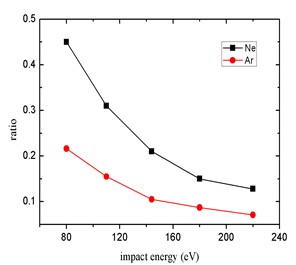The momentum distributions of the recoil ions were measured for the single ionization of atomic targets (Ne, Ar) and molecular targets (CH4, N2, CO2) at incident electron energies ranging from 80 eV to 220 eV by using the reaction microscope, at the Institute of Modern Physics, Chinese Academy of Sciences (IMP).
It was found that there are a remarkable number of recoil ions with large longitudinal momenta, which corresponds to the backward scattering (scattering angles larger than 90o). The appearance of the large momentum recoil ions indicates that the strong interaction between the incident electron and the target core plays an important role both in the single ionization of atomic targets and small molecular targets.
In addition, the relative contribution of the backward scattering process for Ne (e, 2e) reactions decreases faster than that for Ar (e, 2e) reactions with the incident electron energy increasing (see figure 1). This observed feature has been qualitatively interpreted by the different effective potential of the target core experienced by the incident electrons.
Furthermore, based on the independent atom model, the researchers suggested that the heavy atoms in the molecules are independent scattering centers in (e, 2e) reactions, and intuitively explained the characteristics of the momentum distributions (see figure 2) of the recoil ions CH4+, N2+ and CO2+, respectively.
The results were published in Phys. Rev. A 86 012712(2012).
The article can be linked as follows:http://pra.aps.org/abstract/PRA/v86/i1/e012712

Fig.1 The ratio of backward to forward scattering process in Ne (solid square), Ar (solid circle) (e, 2e) reactions at the impact energy ranging from 80 to 220 eV. (Image by IMP)

Fig.2 Longitudinal momentum distributions of CH4+ (a), N2+ (b) and CO2+ (c) for an incident energy of 144 eV, respectively. (Image by IMP)

